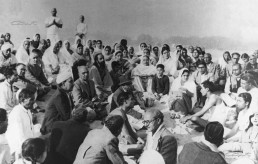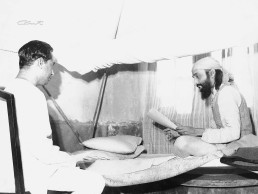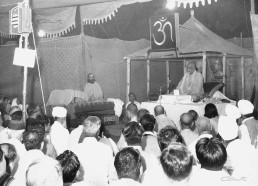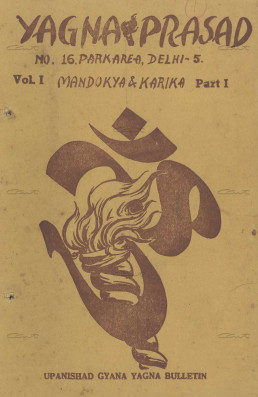
Jnana Yajna 3

Year & Dates:
September 12, 1953 to December 10, 1953

Yajna Topic:
Mandukya Upanishad

Place:
Karol Bagh, New Delhi, India.
An impactful metamorphosis inside a bustling metropolis – in the 91 days after an orange ‘sannyas’ flag bearing the all-encompassing Om symbol was unfurled in the yajnashala at Karol Bagh, New Delhi, the transformation was striking. The educated elite, the agnostics, atheists, the seekers, the people of other faiths and the staunchly-faithful sat as one, spellbound. How could an Upanishad, that too the shortest with twelve verses, reconfigure their entire outlook? But Mandukya Upanishad and Gaudapada Karika as expounded by Pujya Gurudev Swami Chinmayananda took the most fortunate in Delhi to heights of profound silence. The discourses immersed them in the inmost experience of the all-pervasive Om. Even His Guru, Swami Tapovanam, was overjoyed that a materialistic city had halted in meditation on the Highest Truth.
A Spiritual Toolkit for Sadhana
The third Jnana Yajna revealed not only the direct path to the Supreme Essence but also empowered seekers with practices of Sadhana. The features which Pujya Gurudev had included in His Jnana Yajna from the very beginning were becoming an unforgettable part of a collective spiritual journey. The Akanda Kirtan and chanting of the Mahamantra, “Hare Rama Hare Rama, Rama Rama Hare Hare; Hare Krishna Hare Krishna, Krishna Krishna Hare Hare,” kept echoing across Delhi. When even children participated in a 11-day Kirtan, when all the audience did an Akanda Japa of “ Hari Om,” and when everyone completed a Likhita Japa (a written Japa) during the end of the third Upanishad Yajna, the power of constant remembrance in the path of purity was understood. When Swamiji revealed the meaning behind Deepavali and Navaratri during the celebrations during this Jnana Yajna, devotion added a special glow. When the devotees’ sacred immersion in the holy waters of Yamuna was complete, it was beautifully clear that the core of Hinduism was being revitalized in that milestone Yajna.
In Admiration
Rahila Ansari, a Muslim introduced to the luminous wisdom of Pujya Gurudev Swami Chinmayananda through a dear friend, eloquently reveals the profound impact these discourses had on her. In her own words, she gracefully confesses, “I went to the lectures partly out of curiosity, but mainly to please and humour my friend. But imagine my bafflement, it did not take me long to feel that I had a right to me there. There was hardly any talk of God, but Godliness prevailed. Hinduism as expounded by Swamiji was not a religion based on old wives tales, but on a practical and highly developed code of morality. Swamiji’s lectures have certainly enlarged my views, destroyed my prejudices and brought me to a pinnacle from which I can see all human beings equally blessed! I am grateful to Him for this!”
Photo Gallery
Yajna Prasad: An Instrument to nourish our core
The Yajna Prasad booklet, distributed weekly to seekers during the Yajna, carried a resolute message from Pujya Gurudev. It underscored his unwavering commitment to serve and remain connected with all earnest seekers. It states “Swami Chinmayananda is always at the service of all sincere seekers and all are welcome to him. You can open at any time free correspondence with the Swami. Clear all doubts; what remains then is Knowledge supreme.”

“Think,” Says Pujya Gurudev!
Although only a few of us complain against the ‘wandering mind’ almost all of us are conscious of the mind. Yet, very rarely, if at all, does any one of us definitely know what the mind is. Unless we know what the mind is, it must certainly be difficult to control it. This ignorance is mainly the cause of all failures of Truth-seekers in spite of their diligent practice.
From Mandukya Upanishad Yajna Prasad Vol. 2, p. 42
“All that is past, present and future is, verily, OM.” All that was, that is, and that shall be, meaning the entire world of objects cognized by our forefathers, by our forefathers, by ourselves and by our children, …the entire world has but one substratum, which is unchanging in all the three periods of time, and it is represented by the symbol and name “OM”.
Here also it may be possible that the student may fall in to another misunderstanding that the world, conditioned by time alone has “OM” as its substratum and that it is not the ground for the world of experiences that are beyond the concepts of time, space and causality. Thus, the Master clearly emphasises here that “OM” is a substratum for all that is limited in time and also for all that is not conditioned by it, meaning that which is even beyond the triple concepts of time.
The concept of time is a trick of the mind. Where there is no mind, this concept of time also does not function. But we all know that mind is in itself matter, inert and insentient. When the mind is in conjunction with life; it gains a similitude of activity in its sentience and conscience. Thus, that, which is beyond time, is the very Divine Spark of life, because of which, this assemblage of body mind and intellect functions as though it is a vibrant and dynamic being.
Thus, “OM” represents in its symbolism, as well as in its syllabic-significances, not only the manifest world of plurality, but also its substratum, the unmanifest, Non-dual Reality.
From Mandukya Upanishad Yajna Prasad Vol. 5, p. 34
Understand the essence of Om
Let’s revisit the Yajna on Mandukya Upanishad in New Delhi, juxtaposed with a subsequent discourse delivered at Sidhbari in 1991 with this short excerpt.
Unravel the transformative power of “Om” and its role in expanding consciousness. Discover how the teacher becomes an empty reed, allowing the divine to express through, and how the declaration that everything is Brahman transcends time and form.





